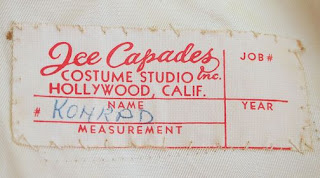It's once again time to unpack the mail bag, answer some of your questions and share some of the interesting e-mails and social media messages that have come my way over the last few months. As always, if you have a question you'd like me to tackle or feedback on a blog please reach out via e-mail.
READER QUESTIONS
From Frank (via e-mail): "How did families afford skating lessons for their children during The Great Depression?"
A: Great question, Frank! I suspect the answer is that many families sadly didn't. Skating is a very expensive sport and was back in those days as well. Although there are certainly exceptions, many of the families that got involved in the sport in the twenties and thirties were 'comfortable' financially, or at least the father's occupations would suggest that on paper.
From Margaret (via Facebook): "Hello, I am trying to learn more about a jacket I found in Spokane, Washington. It was apparently worn by Alan Konrad of the Ice Capades. I presume he wore it prior to 1965. It fascinates me. I wonder why it is in Spokane."
A: Hi Margaret - this one's honestly a stumper to me! I believe Alan Konrad was from NY/NJ so I'm not quite sure why one of his skating costumes would have ended up in Washington. Perhaps he had family or friends there or the jacket ended up in some sort of theatrical costume collection - I know a lot of theatre companies source costumes from all kinds of unexpected places. I wish I had an answer for you but I don't.
From Janet (via e-mail): "Hello -- I'm a regular reader of your blog, and I was wondering if you know of someplace online (or a book) that details the changes over the years to the 6.0 scoring system? Specifically I'd like to know the percentages of the total each part of the competition was worth in a specific year. (This question is inspired by my watching the 1980 Worlds last night and getting a little puzzled by the placements in the Ladies' competition.)"
A: Glad you're enjoying reading and a great question... One book that I'd recommend for you is the late Sandra Stevenson's "The BBC Book Of Skating". It came out just prior to the 1984 Olympics and has a chapter called "Working Out The Results" which gives a really great explanation of how the scoring worked under the 6.0 system in the late 70's and early 80's. Benjamin T. Wright's ISU history book that came out in the 90's would give a good timeline of the changes as well. There was also an excellent series of articles on the history of judging that came out in the PSA's magazine a few years back.
From Rob (via e-mail): "Can you please help me. I am doing my family tree. A distant relative has come up and I can’t find out anything about her. Her name is Audrey Florence Ellen McCue who apparently was an ice skating champion in South Africa from around 1945 to 1955. Do you know where I can look for more information about her?"
A: I don't have a lot of materials on South African skating but the good news is that British skating magazines of that period often mentioned events in South Africa as it was part of the Commonwealth at the time. South African skating was also mentioned occasionally in "Skating" magazine. I was able to find a mention of an Audrey McCue from 1947. She won a mixed singles competition (men and women competing against one another) as well as the pairs and ice dance events at a series of events put on by the South African Skating Association in May and early June of 1947. Her partner in the pairs and dance was Travers Penrose. In the first official South African Championships after World War II in 1950, she finished third in the singles event (again mixed) and won the ice dance, again with Travers Penrose.
LUTZ
In the last Reader Mail edition, I mentioned a historical fiction novel based on the story of Alois Lutz, the little-known inventor of the Lutz jump. This French-language book is now available on Amazon.
"I'M GOING TO BE A STAR"
From Greg (via e-mail): "Fritz Dietl's rink is in Westwood, next to my small town of Hillsdale. My sister taught skating at Fritz' rink (Elaine Zayak was one of her pupils). In fact, I went to pick her up one day and she introduced me to Elaine, who was about 8 or 9 and she came bouncing up and said to me: 'I'm going to be a star' - how's that for precocious? I went to Hartford to watch Elaine win the World's in 1982 and I have a full contact sheet of photos of that."
ROUND DANCING IN VIENNA
From Reinhard (via e-mail): "You have a wonderful blog! I have many old books of skating but you have read much more. We dance on ice in a circle in Vienna since 155 years ;-) Perhaps our page is a little bit interesting for you - we do it just for fun - not for competition: https://www.eistanz-wien.at/en/"
Skate Guard is a blog dedicated to preserving the rich, colourful and fascinating history of figure skating. Over ten years, the blog has featured over a thousand free articles covering all aspects of the sport's history, as well as four compelling in-depth features. To read the latest articles, follow the blog on Facebook, Twitter, Pinterest and YouTube. If you enjoy Skate Guard, please show your support for this archive by ordering a copy of figure skating reference books "The Almanac of Canadian Figure Skating", "Technical Merit: A History of Figure Skating Jumps" and "A Bibliography of Figure Skating": https://skateguard1.blogspot.com/p/buy-book.html.





